Leveraging Warehouse Automation with Automated Case-handling Mobile Robot (ACR)
ACR is the most cost-effective type of warehouse automation solution to increase throughput while decreasing labor. Warehouse automation makes warehouse processes more efficient and robotics technology has also evolved into well-developed, autonomous, and ready-to-deploy automation solutions.
As countries extend their quarantine measures due to the coronavirus (COVID-19) pandemic, warehouses, and factories worldwide keep facing overwhelming challenges. Social distancing has become common in many workplaces, and online shopping continues to rise globally, just in the US and Canada, there has been a 129% year-on-year growth as of April 21.
Warehouse Automation Solutions
Understandably, companies are trying to adapt their strategies, and some look at warehouse automation solutions to increase throughput while decreasing labor.
There is no doubt that warehouse automation makes warehouse processes more efficient. In fact, automation can address many operational pain points. And now robotics technology has also evolved into well-developed, autonomous, and ready-to-deploy automation solutions. But are robot-based solutions the right and most cost-effective type of automation for your business?
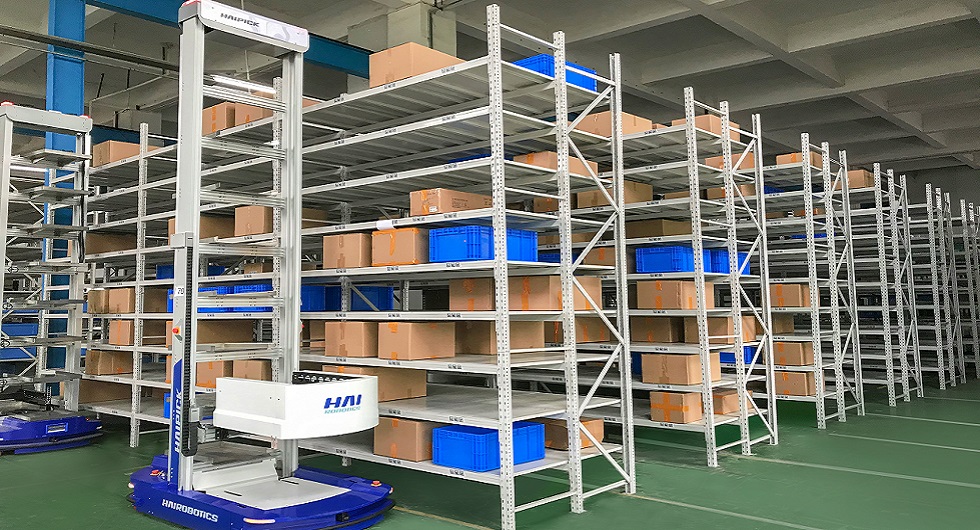
What Is ACR?
Autonomous Case-handling Mobile Robot (ACR) are autonomous robots that can take part in the goods-to-person (G2P) automation model in a warehouse. They are a hybrid between AMRs and grown moving vehicles with a shuttle-type retrieval function to handle totes from static shelving.
According to the Goods to Person Solutions 2020 report by STIQ, ACRs offer a high-performance yet affordable solution compared to other warehouse technologies.
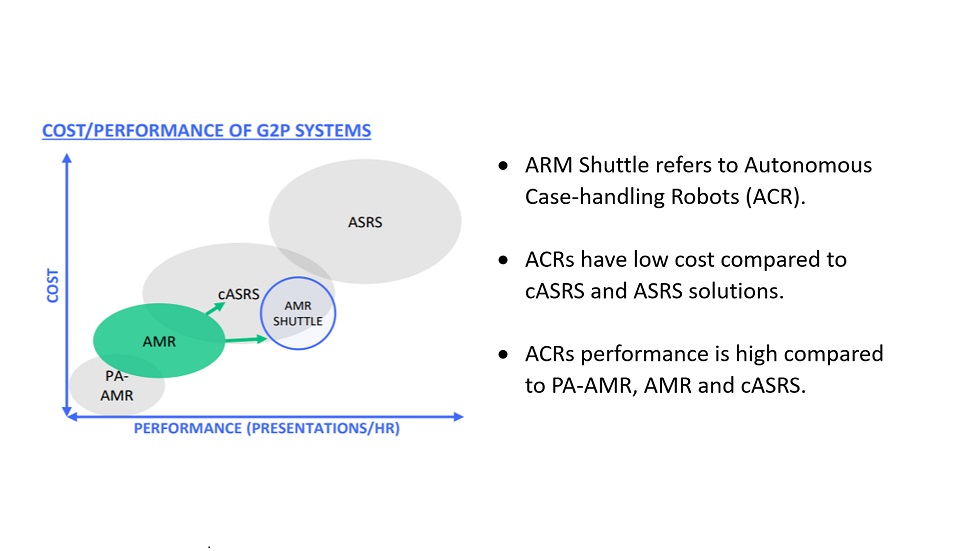
Source: Goods to Person Solutions 2020, published by STIQ (download free report)
How Does ACR Improve Your Business?
Within warehouse operations, the picking processes represent as much as 55% of the total operational expense. Therefore, optimizing these processes allow companies to reduce costs significantly and increase warehouse efficiency.
With their ability to increase productivity, accuracy, and operational efficiency, ACRs offers several benefits, as explained below.
Accuracy and Efficiency Improvements:
ACRs are powered by intelligent software that allows the robots to accurately pick the right item faster compared to manual picking, significantly improving picking accuracy by up to 99.9%.
With a carrying capacity of up to 9 totes and advanced path planning algorithms, ACRs can achieve unprecedented high efficiency of 3-4 times (per worker) higher than manual labor.
The operators do not need to spend time finding the right totes. The robots bring only the required totes, and if possible, the schedule is arranged so that each tote can fulfill multiple orders.
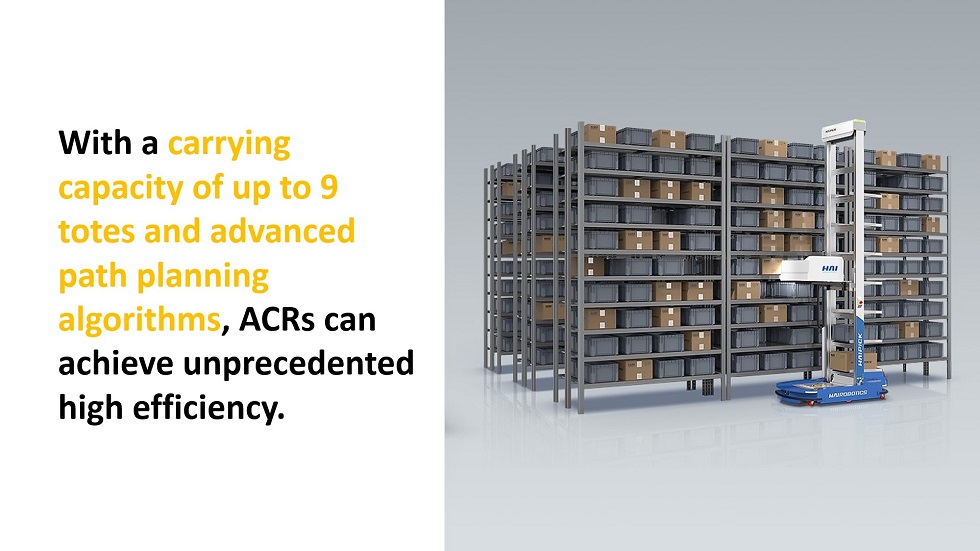
Optimized Storage Density:
One advantage of ACRs is the superior inventory density. Comparable robot technologies offer storage heights of <2m. ACRs enable storage heights of up to 4.5m, optimizing the storage space in a warehouse up to 2.3 times compared to a manual warehouse, providing more space for more items.
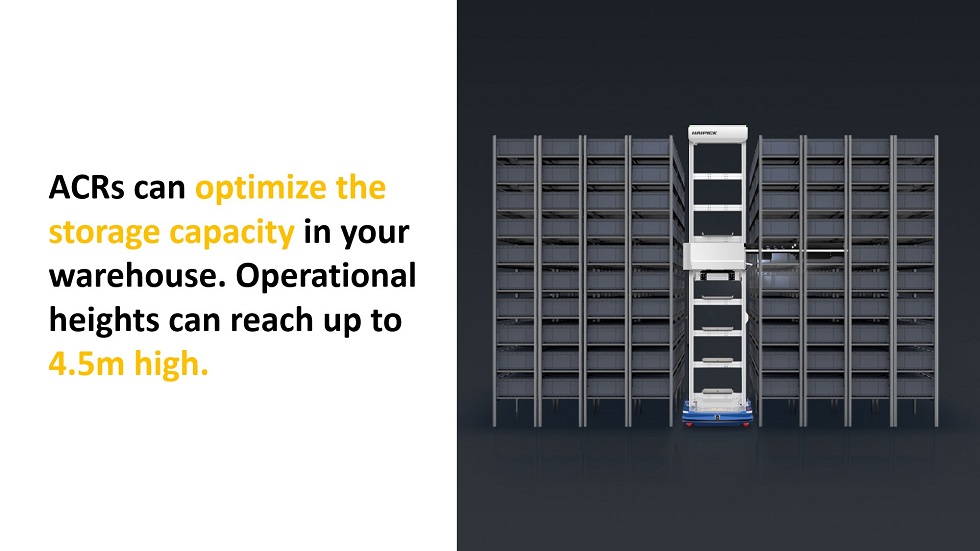
Fast Implementation:
Typically, project implementation can be realized within a week, and commissioning within one month (depending on the project size). Different warehouse automation solutions such as AS/RS take over one month to deploy and almost one year for commission.
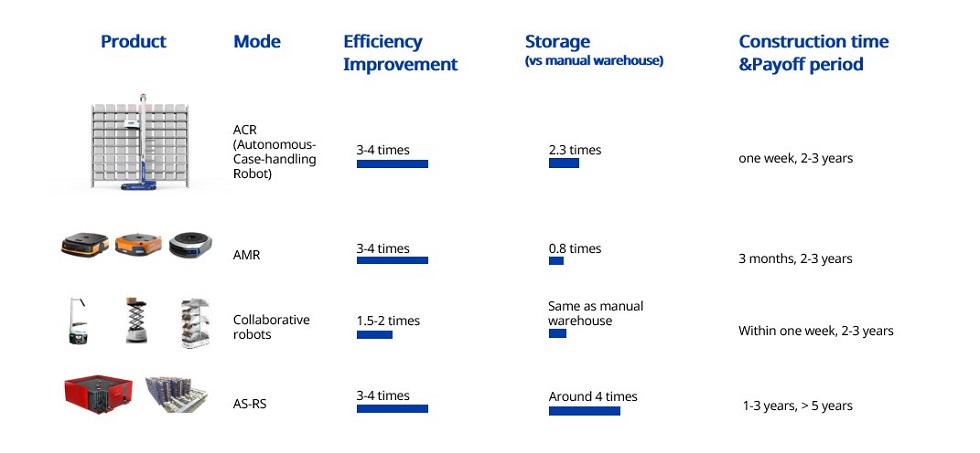
Global Warehouse Automation Products Comparison, Source: Hai Robotics
Flexibility:
One significant advantage of ACR systems is that they can be easily removed from another location. Construction and tuning of a traditional automation system take one to three years, and it is nearly impossible to move to another warehouse once built. The flexibility of ACR systems makes it easier to deploy and transform.
Additionally, ACR systems offer an easy-to-adapt solution applicable to new types of goods. Suppose a warehouse is changing the nature of goods it deals with, drastic changes like this may not be possible with AS/RS system without involving elaborate redesign, time-consuming removal & reinstallation, and elevated costs.
Reduced Labor Costs:
Since robots participate in the picking process, workers can focus on other essential tasks. ACRs allow workers to stay at the workstations while the (correct) goods are automatically presented just in time for each outbound order. Typically, each workstation requires only one worker. Besides, ACRs support multiple interactions with other equipment. A completely automated logistics solution can be realized when the robots interact with robotic arms or conveyors.
The Trends of Warehouse Automation
According to LogisticsIQ, there are substantial growth opportunities in the warehouse automation equipment space owing to several structural trends in consumer demand within e-commerce, retailing, and 3PL logistics. The Warehouse Automation Market was valued at USD 13 billion in 2018 and is expected to be worth USD 27 billion by 2025.
A growing number of warehousing and logistics companies are incorporating robots to obtain the benefits of speed, efficiency, and increased profits to remain competitive in a market driven in large part by consumers that demand rapid fulfillment. According to a report from Tractica, global sales for logistics robots will rise from 194,000 units in 2018 to nearly a million (938,000 units) in 2022.
The Bottom Line
Warehouse automation is a growing trend, and it’s becoming the natural way of boosting competitiveness in the complex warehouse business scenario. Investing in the right warehouse automation solution is a smart decision that will allow you to reduce operational costs and increase productivity exponentially, thus, meeting customers' requirements faster. Autonomous Case-handling Robots offer a cost-effective and high-efficient solution that has been proven in recent years.
Related Article-
How autonomous case-handling robots (ACR) enable smart warehousing?
